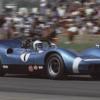Cabianca raises some interesting points. I have my view on some of these questions, but do not claim that they are necessarily the answers. So many players from those days are unable to share their knowledge anymore, and the USAC series itself suffered from lack of reporting in those days.
Just for kicks let's look at the 1959 high water season of 11 races. The first race, Daytona, was not repeated. Could this have been because USAC washed its hands of the track after the disastrous Indy car race that year? Two fatalities on a track that USAC subsequently ruled as unsafe for its cars. That would have likely influenced the scheduling of a USAC RRD event. Pomona was sponsored by the Los Angeles Examiner newspaper, as its response to the previous October's hugely successful Riverside event sponsored by the rival Los Angeles Times. However, the Pomona fair grounds track was just not fit for this type of event and the Examiner moved it to Riverside for 1960 before they got out of the race game entirely. Meadowdale ran three events but lost money at all three. Why keep banging one's head against the wall? Lime Rock Park ran two. with a weak entry in one. I can only speculate that financial considerations led this track to exit the series. Riverside ran two. One, the LA Times GP, was hugely successful and carried on for years into the Can Am days. The other was in mid summer and was a promotion by the local Kiwanis organization. I can only speculate that two things combined to eliminate this particular event. One was the LA Examiner moving its event from Pomona to Riverside, thus causing the Riverside people to question the viability of having three such races in one year. The other is that the Kiwanis group found itself with little appetite to repeat the hassle of such an endeavor. Vaca Valley ran a race but may have found that it was not the financial boon hoped. Watkins Glen had the season closer, but none of the USAC series regulars showed up, leaving the race to Stirling Moss in the Yeoman Credit Cooper and a bunch of USAC midgets and local sports racers. I wish Michael Argetsinger were here to tell us what happened, but I speculate that the track's eye was focusing intently on getting a F-1 race and they felt that the best path to this was not through USAC.
Hanging over all of this, of course, was the open animosity between USAC and the SCCA with threat, counter threat, boycotts, suspensions, etc, flying around constantly. It was not an atmosphere in which a promoter wished to place himself.
Mind you, the above is just my own musings, and I make no claim that it is what actually happened.
Tom



















